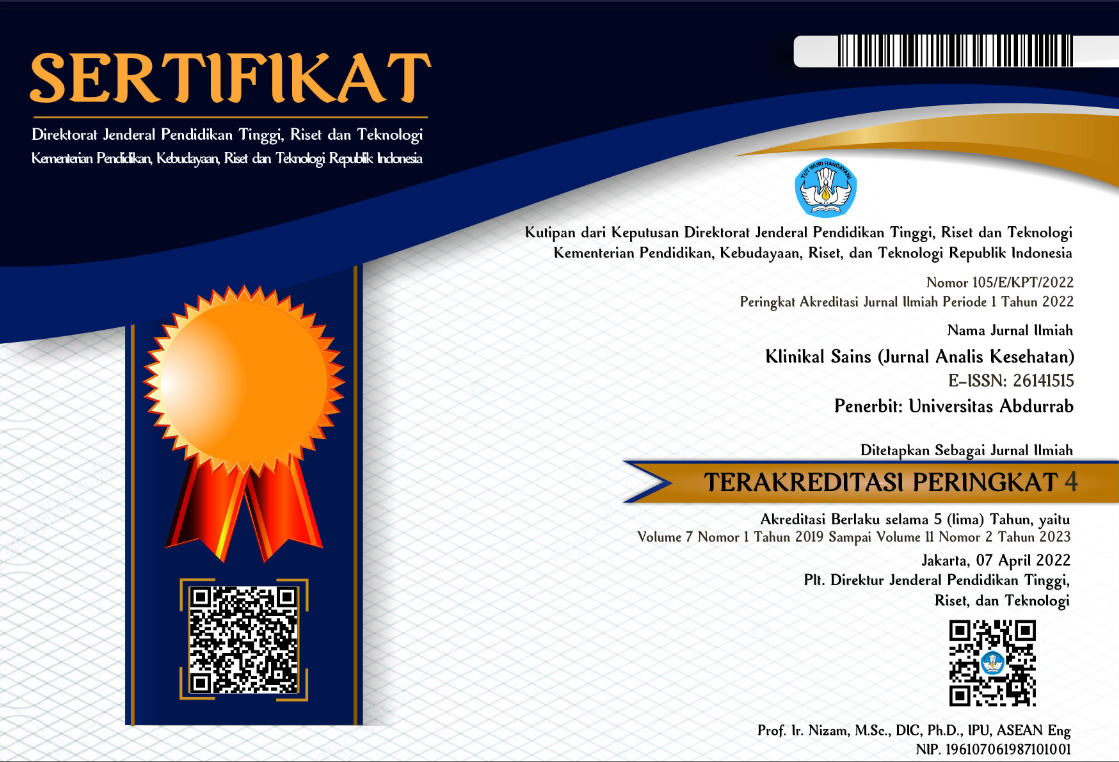UJI DIAGNOSTIK UJI DIAGNOSTIK PEMERIKSAAN NITRIT DENGAN KULTUR URIN PADA SUSPEK INFEKSI SALURAN KEMIH
UJI DIAGNOSTIK PEMERIKSAAN NITRIT DENGAN KULTUR URIN PADA SUSPEK INFEKSI SALURAN KEMIH
Abstract
Urinary tract infection (UTI) is the second largest infection after respiratory infection and can cause sepsis. Urinary tract infections occur due to the entry of microorganisms in the urinary tract. The urinary tract that is usually infected is the urethra (urethritis), bladder (cystisis), ureter (ureteristis), kidney tissue (pyelonephritis). This study aims to determine the sensitivity and specificity of the diagnostic test of nitrite examination with urine culture in suspected urinary tract infections. The method of this study is a descriptive-analytical study with a cross-sectional retrospective approach, conducted in the STIKes field laboratory with the population studied in this study were all patients diagnosed with urinary tract infection with a sample size of 50 samples. The results of this study showed positive nitrite results as many as 17 people, 34% percentage, and negative nitrite results as many as 33 people with a percentage of 66% and on urine culture examination obtained positive results as many as 17 people with a percentage of 34%, which results in growth of bacterial colonies on cultures> 100,000 CFU / mL and negative results of 33 people with a percentage of 66%. Sensitivity Results 82%, Specificity 90.9%. The conclusion of this study is the value of sensitivity, high specificity so that the nitrite test with urine culture can be applied to help diagnose UTI.
References
Endriani, R., Andrini, F., & Alfina, D. (2012). Pola Resistensi Bakteri Penyebab Infeksi Saluran Kemih (ISK) Terhadap Antibakteri di Pekanbaru. Jurnal Natur Indonesia, 12(2), 130. https://doi.org/10.31258/jnat.12.2.130-135
Fitricilia, M., Umboh, A., & Kaunang, D. (2013). Hubungan Enuresis Dengan Infeksi Saluran Kemih Pada Anak Usia 6-8 Tahun Di Sd Negeri Malalayang. Jurnal E-Biomedik, 1(1). https://doi.org/10.35790/ebm.1.1.2013.4582
McLellan, L. K., & Hunstad, D. A. (2016). Urinary Tract Infection: Pathogenesis and Outlook. Trends in Molecular Medicine, 22(11), 946–957. https://doi.org/10.1016/j.molmed.2016.09.003
Pratistha, F. S. M., Sudhana, I. W., & Adnyana, I. W. L. (2018). Diagnosis Cepat Infeksi Saluran Kemih Dengan Menghitung Jumlah Leukosituria Pada Urinalisis Metode Flowcytometry Sysmex Ux-2000 Dengan Baku Emas Kultur Urin Di Rsup Sanglah Denpasar. Jurnal Penyakit Dalam Udayana, 1(2), 52–56. https://doi.org/10.36216/jpd.v1i2.4
Rahmadea Utami, P., Chairani, & Yudha, H. (2020). COMBINATION TEST OF CHINESE LEAF EXTRACT (Leucaena leucocephala folium) AND ALOE VERA INHIBITING GROWTH Escherichia coli. Indonesian Journal of Medical Laboratory Science and Technology, 2(2), 60–67. https://doi.org/10.33086/ijmlst.v2i2.1577
Retno Dwi Hartantia, Nur Oktaviab, A. D. S. S. F. (2020). CHMK PHARMACEUTICAL SCIENTIFIC JOURNAL CHMK PHARMACEUTICAL SCIENTIFIC JOURNAL I . LATAR BELAKANG Infeksi Saluran Kemih ( ISK ) merupakan infeksi akibat berkembang biaknya kasus baru pertahun . Berdasarkan laporan pola penyakit dari unit rekam medis RSUD S. Infeksi, Pasien Kemih, Saluran Instalasi, D I Inap, Rawat Soe, Rsud, 3(April).
Sari, R. P. (2018). Angka Kejadian Infeksi Saluran Kemih (ISK) Dan Faktor Resiko Yang Mempengaruhi Pada Karyawan Wanita Di Universitas Lampung Event Numbers Urinary Tract Infection (Uti) and Risk Factor that Affecting on Female Employees In University of Lampung. Majority, 7(3), 115–120.
Triono, A. A., & Purwoko, A. E. (2012). Efektifitas Antibiotik Golongan Sefalosporin dan Kuinolon terhadap Infeksi Saluran Kemih The. Mutiara Medika, 12(1), 6–11.
Utami, P. R., Indrayati, S., & Hayatang, N. (2021). Ability of Ethanol Extract from Ajwa and Sukkari Dates (Phoenix dactylifera L.) in Inhibiting the Growth of Methicillin-Resistant Staphylococcus aureus (MRSA). Indonesian Journal of Medical Laboratory Science and Technology, 3(1), 1–8. https://doi.org/10.33086/ijmlst.v3i1.1848
Copyright (c) 2021 Klinikal Sains : Jurnal Analis Kesehatan

This work is licensed under a Creative Commons Attribution-NonCommercial-ShareAlike 4.0 International License.
1. Copyright of all journal manuscripts is held by the Klinikal Sains : Jurnal Analis Kesehatan
2. Formal legal provisions to access digital articles of electronic journal are subject to the provision of the Creative Commons Attribution-ShareAlike license (CC BY-NC-SA), which means that Klinikal Sains : Jurnal Analis Kesehatan is rightful to keep, transfer media/format, manage in the form of databases, maintain, and publish articles.
3. Published manuscripts both printed and electronic are open access for educational, research, and library purposes. Additionally, the editorial board is not responsible for any violations of copyright law.
licensed under a Creative Commons Attribution-ShareAlike 4.0 International License.
 pdf
pdf
 Abstract views: 487
Abstract views: 487
 downloads: 969
downloads: 969

 :
:






